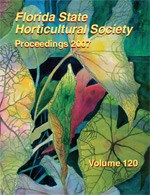Abstract
Fusarium oxysporum (F) and Pythium aphanidermatum (P) were isolated from a diseased snapdragon (Antirrhinum ( majus) planting near Stuart, FL, in 2003. Plants exhibited stem rot and dieback. Snapdragons were inoculated with F, P, or F+P, or were treated with culture media of each fungal treatment. A negative control treated with water was included. In Trial 1 and Trial 2, both treatments with the presence of Pythium (P and P+F) reduced plant height, shoot and root weights, and numbers of flowers compared to the control. Although F slightly reduced plant growth relative to the negative control, plant growth was not different (P < 0.05) between F and potato dextrose broth (PDB) alone, the P substrate for F. When volume of the PDB was reduced in Trial 2, F did not reduce plant growth. In Trial 3 and Trial 4, P and F from the diseased plants in Trial 1 and Trial 2 were re-isolated and inoculated on new plants, confirming the pathogenicity of P on snapdragon and fulfilling Koch's postulates for this pathogen. Young snapdragon seedlings were more susceptible to P than older plants. Young seedlings infected with P showed the stem rot and dieback symptoms as observed in the field where the disease outbreak had originally occurred. Plants inoculated with F did not show these symptoms, confirming that this isolate was not pathogenic.

